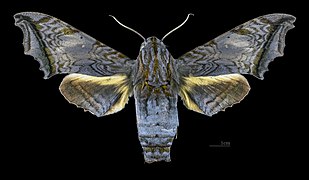| Nyceryx stuarti | |
|---|---|
 | |
| Male dorsal | |
 | |
| Male ventral | |
| Scientific classification | |
| Domain: | Eukaryota |
| Kingdom: | Animalia |
| Phylum: | Arthropoda |
| Class: | Insecta |
| Order: | Lepidoptera |
| Family: | Sphingidae |
| Genus: | Nyceryx |
| Species: | N. stuarti |
| Binomial name | |
| Nyceryx stuarti (Rothschild, 1894) [1] | |
| Synonyms | |
| |
Nyceryx stuarti is a species of moth in the family Sphingidae.

